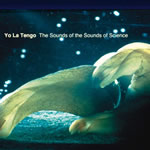|
|
 |
Dusted Reviews
Artist: Yo La Tengo Album: The Sounds of the Sounds of Science Label: Egon Review date: May. 14, 2002 |

|
|
|
 |
Perhaps Yo la Tengo’s most defining trait is their enduring love of sound. Song structures or musical genres are far less important to the band than an interesting use of feedback or a particular reverb effect on a guitar. Even their most “pop” album, I Can Hear the Heart Beating as One features “Spec Bebop”, ten minutes of droning keyboards and feedback that is just as integral to the record as “Sugarcube” or “Autumn Sweater”. In lesser hands, this love for atmospherics might turn into some kind of pretentious free-jazz abomination of formless experimentation, but Yo la Tengo’s appeal has always been in their ability to make engaging music, whether it’s an acoustic love song or a storm of white noise.
A similar eclecticism rooted in aesthetics rather than in content or form can be found in the work of filmmaker Jean Painleve, whose films Yo la Tengo have scored for a series of concerts recently performed in the U.S. and England. Painleve’s films are about natural subjects, such as liquid crystals, seahorses, or the peculiar mating ritual of the octupus. But while they do provide insight into the behaviors of these animals, this is not the primary interest of Painleve, nor is it the chief accomplishment of his films. Rather, he uses film to explore the poetry, beauty, and humor of the undersea world and the strange creatures that inhabit it. One scene in the seahorse film features a shot of a female seahorse giving birth filmed in such a way that the ejected young become blurred, spinning projectiles, pure cinematic abstractions made of moving pieces of light. The effect is mesmerizing.
I was late in arriving to Yo la Tengo’s April performance with the films in the Somerville Theatre, and the first piece I saw was Painleve’s Liquid Crystals. Yo la Tengo played a low, hushed drone as the titles came up, and the screen went to black. Suddenly, a strange mass of silvery hexagons spreads across the screen, and the band erupted into a torrent of feedback and off-kilter percussion. If one had been on drugs, the experience would have been mind-bending. Sober, it was still quite something to behold. The colors and shifts in shape in the film were astounding, and the music gave it all a disorienting, transporting effect. Another film, The Love Life of the Octopus is in turns very funny and somewhat creepy, following the pursuits of a small male octopus and his much larger female conquest. Their mating was a combination of wrestling and some kind of ballet, with tentacles all over the place. The music reflects this strangeness, creating bass- and keyboard-driven atmospherics that build tension until the male and female come together and made sweet octopus love, resulting in a quasi-funk crescendo.
As either a souvenir or a painful reminder that you missed the shows, Yo la Tengo has begun offering a recording of the music on their website . The album, made with longtime producer Roger Moutenot, works just fine without the visuals, and is easily one of the best albums to get stoned to in recent memory. Although a couple of tracks seem to meander off to nowhere without the films to hold them together, much of this album is as textured, lush, and compelling as anything Yo la Tengo has made. Both the freedom and the challenge of the task seem to have energized the band, and the lack of structure imposed on the music benefits much of it greatly. Yo la Tengo is able here to create pure sound, without the necessity of forming it into a song. Thus, “Acera or the Witches’ Dance” sustains itself for several minutes on nothing more than a simple repeated keyboard phrase, and “Sea Urchins” skitters along on lightly brushed drums and gentle feedback. Standouts include “Acera”, the brooding “Octopus” number, the strange near-funk of “How Some Jellyfish Are Born”, and the opener, “Hyas and Stenorhynchus”, a poppy, droning song that sounds not unlike something from the I Can Hear the Heart… era.
Pure aesthetics, beauty for beauty’s sake, is often reviled as an artistic pursuit. People who are serious about this stuff will tell you that beauty without content is a wasted effort, but one of the things that is so wonderful about music in comparison to the other arts is that sometimes, beauty is enough. Listening to The Sounds of the Sounds of Science is like eavesdropping on a Yo la Tengo practice session or a soundcheck. Paths are explored without any concern for where they might lead, and if something sounds good, the band is content to ride it out for a long time, allowing for subtle variations to gradually alter the piece. In lesser hands, this could be a disaster, but Yo la Tengo are such inventive and fluid players that the music feels both utterly spontaneous and well-practiced, the sound of a band in love with sound, and making music for the simple pleasure of it.
By Jason Dungan
|







